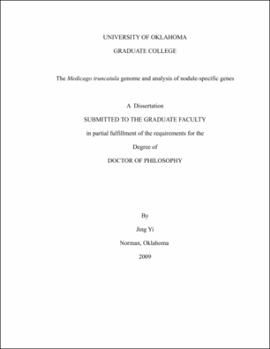| dc.contributor.advisor | Roe, Bruce A | |
| dc.creator | Yi, Jing | |
| dc.date.accessioned | 2019-04-27T21:27:42Z | |
| dc.date.available | 2019-04-27T21:27:42Z | |
| dc.date.issued | 2009 | |
| dc.identifier | 99211541902042 | |
| dc.identifier.uri | https://hdl.handle.net/11244/318744 | |
| dc.description.abstract | The nitrogen-fixing plant Medicago truncatula is an important model system for identifying legume genes and determining their functions. With over 255 megabases of the genome, representing about 85% of the euchromatic regions, having been sequenced, my analysis reveals 50,540 predicted protein-encoding genes, 632 tRNA genes, 45 miRNA precursor candidates, and repetitive elements covering 11% of the sequence. ~ 50% predicted genes are supported by ESTs or TCs. About 40% of the predicted genes are intronless and there is evidence for 55% of them being expressed. A comparison of the Medicago truncatula, Oryza sativa, Arabidopsis thaliana, Lotus japonicus, Glycine max, and Populus trichocarpa genomes shows that the Medicago genome uniquely contains a high number of very short genes encoded by predicted genes with fewer than 99 nucleotides. The Gene Ontology (GO) annotation of the predicted genes showed that the nucleic acid binding domains are the most abundant domains in M.truncatula. The comparison between GO the annotation of M.truncatula, O. sativa, A.thaliana, L. japonicus, G. max, and P. trichocarpa reveals that all the six genomes have similar percentage of each of the major functional domains. The comparison of the top 40 Interpro domains in M. truncatula with the corresponding domains in the other five plants also indicates that most of the overrepresenting domains are overrepresenting in all the six genomes although some species-specific domains, such those for late nodulation, only are present in M. truncatula. | |
| dc.description.abstract | The in silico analysis of the Medicago Gene Index 9.0 revealed that 191 genes only are expressed in root nodules, with100 of them similar to known GenBank sequences. Of the several gene familys, my analysis of 50 nodule-specific cysteine-rich peptides (NCR) indicates that they have a conserved signal peptide, a conserved cysteine motif, and a highly divergent remaining sequence. Many of the NCR genes are clustered while others are dispersed throughout the Medicago genome, suggesting that they have ungone a recent tandem or segmental gene duplication. A Ka/Ks analysis of NCR genes indicates that although some NCR genes underwent positive selection, others underwent purifying selection. That the NCR intron sequence is highly conserved suggests it may act as an enhancer for nodule-specific NCR gene expression in combination with the conserved upstream cis-acting motifs. The phylogenetic tree of both defensin and NCR genes reveals that after gene duplication, some of the defensin genes still remained defensins as is the case with the five medicago defensins, while the other duplicated defensin genes mutated such that they now seem to function in symbiosis as NCR genes. | |
| dc.description.abstract | I also analyzed the three members of the glycine-rich peptide (GRP) gene family that are encoded on chromosome 2. These studies reveal that the GRP1 gene that is 5.2 Mb from the GRP2-GRP3 cluster arose from tandem gene duplication followed by either a deletion or an insertion from a common ancestor, an idea that is supported by sequence conservation in the signal peptide, the glycine-motif, and the 200bp upstream DNA sequence. In addition, my Ka/Ks analysis indicates that positive selection played an important role during GRP gene evolution. Furthermore, the Leghemoglobin (Lb) genes that originated from nonsymbiotic hemoglobins (Hb) seem to have undergone a purifying selection that has preserved their ability to function during oxygen transport. Finally, the nodule-specific genes all seem to contain one or both of two nodule-specific motifs (CTCCT and AAAGAT) in their promoter regions suggesting that nodule-specific gene expression likely is co-regulated and about 50% of the predicted nodule-specific genes are clustered and have corresponding EST, indicating that they are expressed in root nodules. | |
| dc.format.extent | 141 pages | |
| dc.format.medium | application.pdf | |
| dc.language | en_US | |
| dc.relation.requires | Adobe Acrobat Reader | |
| dc.subject | Medicago | |
| dc.subject | Genomes | |
| dc.subject | Nucleotide sequence | |
| dc.subject | Root-tubercles | |
| dc.title | The medicago truncatula genome and analysis of nodule-specific genes | |
| dc.type | text | |
| dc.type | document | |
| dc.thesis.degree | Ph.D. | |
| ou.group | College of Arts and Sciences::Department of Chemistry and Biochemistry | |
